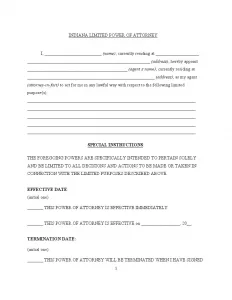Indiana Limited Power of Attorney Form
The Indiana Limited power of attorney document is a legal form that allows an individual, known as the “principal,” to appoint another person, known as the “agent” or “attorney-in-fact,” to perform specific tasks on their behalf. This form is “limited” because it restricts the agent’s authority to a particular activity or set of activities.
For example, a limited power of attorney can give someone the authority to handle real estate transactions, manage financial accounts, or make medical decisions, but only under the circumstances specified in the document. It is often used for one-time financial transactions or medical directives when the principal cannot be present or is incapacitated.
The document must clearly state the powers granted, the circumstances under which they may be exercised, and the duration of the powers. It should be drafted under Indiana law to ensure its validity and must be signed by the principal. Check all Indiana power of attorney forms if you need more state-specific templates.

Build Your Document
Answer a few simple questions to make your document in minutes
Save and Print
Save progress and finish on any device, download and print anytime
Sign and Use
Your valid, lawyer-approved document is ready
Under Indiana Code, Title 30, Article 5, creating a limited power of attorney must adhere to specific signing requirements to ensure its legality. According to § 30-5-4-1, a power of attorney in Indiana must:
- Clearly name a person as the attorney-in-fact, who is given the authority to act on behalf of the principal.
- Explicitly state the powers conferred to the attorney-in-fact, allowing them to perform duties as the principal.
- Be signed by the principal or another individual at the principal’s direction. This signing must occur in the presence of a notary public or witnesses.
If someone else signs a power of attorney on behalf of the principal, this action must be officially recognized. The notary public must verify that the signature was provided under the principal’s explicit instruction.
Indiana Limited Power of Attorney Form Details
| Document Name | Indiana Limited Power of Attorney Form |
| Other Name | Indiana Special Power of Attorney |
| Relevant Laws | Indiana Code, Section 30-5-5-1 |
| Avg. Time to Fill Out | 8 minutes |
| # of Fillable Fields | 32 |
| Available Formats | Adobe PDF |
Filling Out Indiana Limited POA
You must accurately fill out an Indiana limited power of attorney to ensure the designated agent has the proper authority to act on your behalf. Here is a step-by-step guide on how to correctly complete this form.
1. Identify the Principal and Agent
Fill in your full name as the principal, along with your complete mailing address, including the city and state. Then, specify the name of the person you appoint as your agent or attorney-in-fact and provide their mailing address.
2. Define the Powers Granted
Clearly list the specific powers you are granting to your agent. Be precise about what your agent can do to avoid ambiguity or misuse of the power granted.
3. Choose the Duration of the Power
Decide regarding the duration of the power of attorney:
- The document remains effective until your death or revocation.
- The power to remain effective until a specific date, your death, or revocation.
- Non-durable option, where the power ends upon your incapacity, death, or revocation.
Be sure to mark the one appropriate option on the form.
4. Sign and Date the Form
As the Principal, sign the form and date it. Ensure this is done in the presence of a notary public or witnesses, as required by Indiana law for such documents.
5. Agent’s Signature
Have your agent sign the form to acknowledge their acceptance of the responsibilities and powers you are granting them.
6. Witness Signatures (Optional)
If you include witnesses, have them sign the form in the designated areas. They must also provide their printed names, addresses, telephone numbers, and emails. Witnesses add a layer of validity, especially when the principal’s signature’s integrity might be questioned later.
7. Notarization
The final step involves the notarization of the form. Have a notary public witness the signing and fill out the “Acknowledgment of Notary Public” section, confirming that both the principal and the agent (and any witnesses) signed the document in their presence.
After the form is fully executed, distribute copies to your agent, any institutions or individuals who will interact with the agent under this power, and keep a copy for your records.
